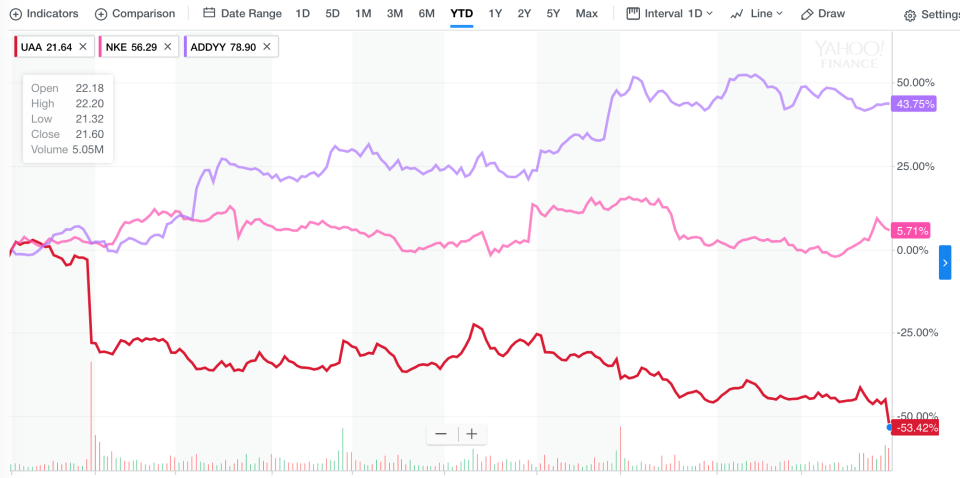Under Armour's slump gets worse, may not make money in 2017
The news in Under Armour’s (UAA) 2017 third-quarter earnings report was mostly bad.
The Baltimore-based sports apparel company reported revenue of $1.41 billion, a decline of 5% vs the same quarter last year. It was its first year-over-year revenue decline as a public company. Analysts had expected revenue of $1.48 billion. Earnings per share came in at 22 cents, a beat compared to analyst expectations of 19 cents.
Most importantly, Under Armour slashed its full-year outlook for 2017. Management now expects 2017 full-year revenue to be up in the low single digits, whereas earlier this year it had predicted gains as high as 11%.
In a press release, Under Armour predicts full-year operating income to come in at “0 to $10 million.” In other words, the company might not cut a profit in 2017.
Under Armour shares fell 15% in early trading on Tuesday.

“Clearly this is a much different profile for the year than we discussed 90 days ago,” said acting CFO Dave Bergman on Tuesday’s earnings call. “On that call, we outlined several key factors we thought would come to fruition… demand and challenges in North America significantly altered the terrain.”
Adjusted for nonrecurring items, management expects to generate operating income of $140 million to $150 million, which would pan out to earnings per share of $0.18 to $0.20.
What’s going wrong for Under Armour?
The biggest problem area for Under Armour right now is its most important region: North America.
Revenue in North America fell 12% to $1.07 billion, with wholesale revenue down 13% to $880 million. Direct to consumer revenue was up 15% to $468 million. This means consumers who like Under Armour are continuing to order product directly from the company. But they are not buying the brand in sporting goods stores; or when they do, it is at a discount.
“We’ve got significant challenges in our North American wholesale business,” CEO Kevin Plank acknowledged, “which represents 60% of what we do.”
U.S. sports apparel is an increasingly promotional environment, meaning that brands are offering a lot of discounts and sales. Back in January, when Under Armour’s streak of 26 straight quarters with 20% or higher revenue growth first ended, Plank identified the discounting problem, and it has only gotten worse since then.
“The role both we and our retailers expect us to play is as a premium, full-price brand,” Plank said at the time. (More recently, in August, he framed things in starker terms: “We’re pivoting.”)
Much of the problem has been the overall decline of brick-and-mortar sporting goods chains. But some analysts are now saying that Under Armour’s problems are not just about the larger market.
“It demonstrates issues with the brand and its proposition,” a GlobalData Retail analyst said. “Especially so since other brands and retailers… have not posted such calamitous figures.”
After all, Adidas is flying high in North America. The German giant is cool again in America, and its stock has responded, up 44% in 2017 so far. Nike is up 6% in that time, Under Armour is down 53%.

Under Armour also saw declines in outdoor gear, women’s training, and youth apparel.
All “performance” (apparel and footwear worn for playing sports) has sold poorly in the U.S. for over a year now, and that’s debilitating to Under Armour, which is a performance-first company. UA “has got to figure out the sportswear business,” says NPD Group analyst Matt Powell. “We are deep in a non-performance cycle.”
Bright spots
It’s not all bad for Under Armour: the brand is growing rapidly outside America.
International revenue was up 35%, though that represented only 22% of overall revenue. It is an area that the company is highlighting amidst its continued bad news. “When we talk about opportunity for this company, it comes down to footwear, women’s, and our international business,” said Plank. “Obviously international is an area that’s kicking really well for us, but women’s and footwear we can improve.”
Under Armour’s footwear revenue was up 2% to $285 million, and the company cited particular strength in running shoes. Footwear is still a tiny part of its overall business.
The third quarter report is the fourth bad earnings report in a row for Under Armour.
“What we’re telling you today isn’t how we ever expect to deliver for the market and our business,” Plank reiterated. “Let me just say again how disappointed we are in the 2017 results.”
This year, Plank said, “is a reset for our business and our brand… We’re certainly not standing still, taking these blows, and saying, ‘We accept this.'”
—
Daniel Roberts is the sports business writer at Yahoo Finance. Follow him on Twitter at @readDanwrite.
Read more:
Under Armour’s business will get worse before it gets better
Under Armour: ‘We’re pivoting’
3 big reasons Under Armour has cooled off
Under Armour CEO: We have to be a premium full-price brand
Adidas blows investors away with stellar 2017 outlook
Under Armour, UCLA, and why the biggest college sports deal ever isn’t such a big deal


